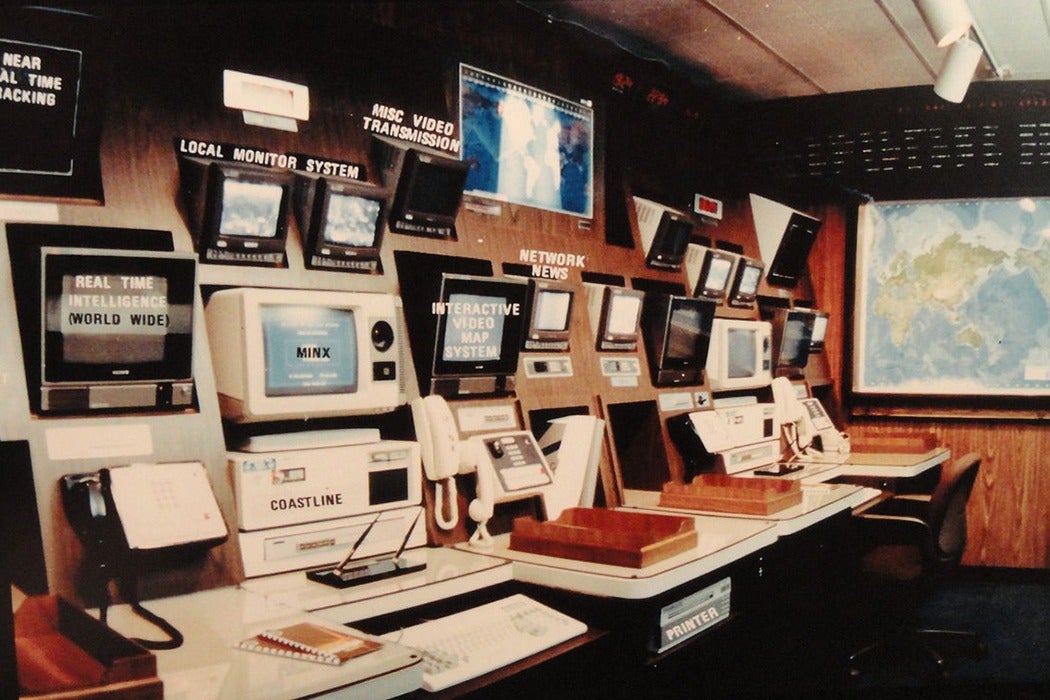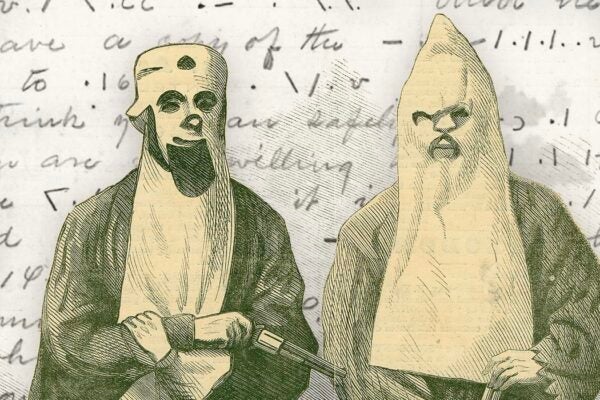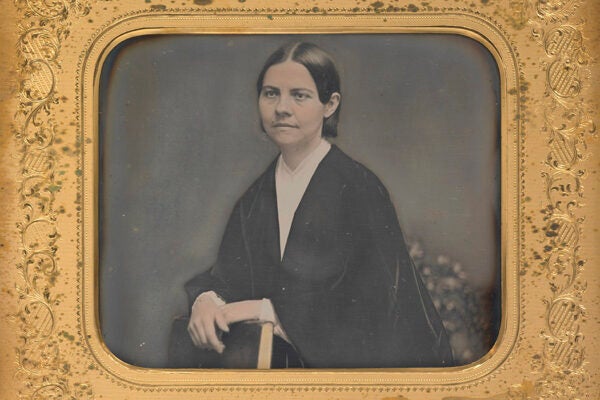As a principle of international statecraft, “security” dates to the end of World War II and the rise of the United States as a superpower. America veiled its new hegemony behind the principle of nation-state sovereignty and exercised its power through economic grants, military aid, and international organizations like the United Nations. Although it dismantled fascist regimes immediately, it also pressured Allies with empires—such as the United Kingdom—into decolonization in following decades. When the Soviet Union acquired nuclear weapons in 1949, the traditional time and spatial limits of interstate war were rendered obsolete. The 1947 National Security Act, which turns 75 this year, anticipated this situation, unifying the various branches of the military and creating the National Security Agency (NSA) and Central Intelligence Agency (CIA), a move that allows the president to exercise US security (i.e., military) power around the globe at any time, in war or in peace.
“Security” and “sovereignty” thus supplanted “war” and “empire” as the conceptual language of interstate conflict. As such, security studies traces its intellectual lineage to the field of international relations as it developed in political science and area studies departments at American universities during the Cold War. The spread of post-Marxist critical theory and post-structuralism in academia, alongside the collapse of the Soviet Union in 1991, opened the way for a large range of critical theoretical perspectives from within and from competing fields. Research about the people abused or ignored by security ideology and the ways states use security to justify and consolidate anti-democratic power has only increased with the intensification of American domestic security theater and its global wars since 2001.
As a historian that studies security, law, and capitalism, I have organized this list chronologically to contextualize and explain the evolution of the field, with a particular emphasis on the rise and diversification of critical viewpoints.
Hans J. Morgenthau, “The Mainsprings of American Foreign Policy: The National Interest vs. Moral Abstractions.” The American Political Science Review, 1950.
From the 1950s to the 1970s, the most dominant intellectual framework in international relations research was realism. A leading theorist of classical realism, Morganthau argues that states do not make foreign policy decisions because of ideologies or the form of their governments but because of the specific context of their immediate interests. Realists developed their theories in part as reaction to the failure of liberal internationalism of the interwar era, embodied in Woodrow Wilson’s “Fourteen Points” speech to US Congress on January 8, 1918. They did so although liberalism survived in the surface-level Cold War ideology then placing the “the free world” in opposition to the communist bloc. This intellectual environment helped justify US decisions to support many dictatorships in proxy wars against allies of the Soviet Union after World War II.
John H. Herz, “Idealist Internationalism and the Security Dilemma.” World Politics, 1950.
In the year following the Soviet acquisition of the atomic bomb, Herz puts the tenets of realism in an even bolder light. With the survival of humanity now at stake in a potential nuclear war, he argues, there is no room for error in international diplomacy. He generalizes this problem to other periods of history, arguing that despite the benefits of “idealist” political or economic coordination, the security dilemma forces all leaders to accrue power to the exclusion of rivals. As a result, practical and contextual negotiations are always more effective than seeking a permanent, all-encompassing diplomatic settlement (i.e., the United Nations).
Johan Galtung, “Violence, Peace, and Peace Research.” Journal of Peace Research, 1969.
By the end of the 1960s, it was clear that the bipolar security balance of the great powers had fostered a new kind of security problem. Because global-scale military conflict was impossible, the struggle for hegemony had shifted into proxy conflicts. These most often occurred in recently decolonized states where the powers fueled struggles over the political orientation of their governments, such as in Vietnam, in Yemen, and across Africa. This shifted the attention of security scholars from existential and state-level conflict back toward the human scale. In this article, Galtung coined the concept of structural violence as any oppression that robs a people of their potential achievement. While later scholars would critique this idea as too broad, it brought theoretical urgency to the suffering of occupied populations that appeared “peaceful” under military occupation or even economic oppression.
Mohammed Ayoob, “Security in the Third World: The Worm about to Turn?” International Affairs, 1983.
Ayoob defined the problem with Western-centric security studies in much clearer detail, establishing a subaltern realism in the field. Although nearly all formerly colonized territories had obtained sovereignty as independent nation-states by the 1980s, they could not act on the international stage in the same fashion as those in the First (Western) or Second (Soviet) Worlds (in the terminology of the era). “Third-World” states, Ayoob argues, are dependent upon more powerful patrons for economic and military support, which not only limits their diplomatic choices, it also warps their domestic politics by robbing governments of legitimacy.
Michael W. Doyle, “Kant, Liberal Legacies, and Foreign Affairs, Part 2.” Philosophy & Public Affairs, 1983.
As the Soviet bloc weakened and more developing nations abandoned socialist experiments, liberalism re-emerged in the field during the 1980s. Michael Doyle’s research into the absence of wars between liberal governments since the Napoleonic era struck a powerful chord with a new generation of researchers tired of the cynicism of the dominant realist paradigm. His democratic peace theory validated strong neoliberal political interests aiming to justify the global spread of capitalism and structural adjustment “in order to encourage democracy.” Although Doyle believed a liberal foreign policy would thus emphasize butter over guns, ironically, neoconservative hawks would greatly abuse the concept of “spreading democracy” to justify war during the George W. Bush administration.
Cynthia Enloe, “Women and Militarization—A Seminar.” The Radical Teacher, 1984.
The entrance of feminist perspectives on security de-centered the state as its subject of research. Enloe was one of the first writers in the field to comprehensively examine the role women play both as objects of military violence and as active participants in military logistics and battle. In this article, she recounts developing a seminar for which she chose the theme of “militarization” to leave open many of the usually closed conceptual categories of security studies: soldier/civilian, masculinity/femininity and public/private. It represents an early avenue into the social history of security.
David Campbell, “Global Inscription: How Foreign Policy Constitutes the United States.” Alternatives: Global, Local, Political, 1990.
Postmodern analysis, which critically deconstructed positivist narratives about history and society, gained popularity in universities in the 1980s and blossomed in every social science field after the end of the Cold War. The demise of the Soviet Union led to uncritical jubilation in many quarters but equally to new introspection about the real purpose of the American security state. Campbell argues that the “necessity” of America’s constant military alertness in the Cold War helped constitute a discourse that supported far more significant domestic power structures: the capitalist mode of production and hetero-normative gender roles, among others.
Ken Booth, “Security and Emancipation.” Review of International Studies, 1991.
Besides postmodernism, the other foundation of critical security studies is post-Marxist critical theory. Booth synthesizes the ideas of the Frankfurt School that the ideal role of government should bend toward freedom and social justice with a critique of the field itself. Indeed, this is the first article on this list to mention “security studies” as a field separate from “international relations.” Booth seeks to reorient the object of study away from power, as realists see the source of security, toward emancipation, in his view the ideal goal of security. This article too was a clarion call to refocus study away from states toward human beings, which provoked a wide range of responses.
Alexander Wendt, “Anarchy is what States Make of it: The Social Construction of Power Politics.” International Organization, 1992.
In a different take on the postmodern turn, Wendt argues that the global “anarchy” that drives states toward “rational” actions in the eyes of realists does not have an intrinsic reality. Rather, the interpretation of anarchy is socially constructed. From the level of state institutions to individual identities, the interpretation of global events is essentially subjective. In a time of great global change that attended security risk, such as the 1990s, constructivists believed that shifting identities held promise for flexible reorientation of priorities in both public opinion and institutions. Although his critical orientation makes Wendt suspicious of the idealism of liberals, his flexible framework makes him more hopeful of finding common ground than with the realists.
Barry Buzan, “Rethinking Security after the Cold War.” Cooperation and Conflict, 1997.
Buzan had made waves early in his career by highlighting a variety of non-state-centric aspects of security in his 1983 book People, States and Fear. But in the 1990s, he defined one of the most important new branches of critical security studies with the concept of securitization. As with many of the critical perspectives above, Buzan argues that no political or violent problem is inherently the subject of security. In his view, states or other powerful interests seize upon disjunctive events and infuse them with the language and institutions of security to accrue unaccountable power. If the target public accepts this maneuver, a new problem becomes “securitized.” Buzan and other adherents thus generally believe “security” is too broadly applied and support political measures for “desecuritization.”
Douglas T. Stuart, “Ministry of Fear: The 1947 National Security Act in Historical and Institutional Context.” International Studies Perspectives, 2003.
The September 11, 2001, attacks prompted the Bush administration to reshape the American security establishment by creating the Department of Homeland Security. Stuart uses this event as the framework for re-examining the 1947 National Security Act. The dilemmas and weaknesses of the act have never fully resolved the questions: Was coordinating all military activities so closely in the hands of a small body of bureaucrats (the NSA) worth the loss of input from other civilian institutions (the State Department)? Is the government destined to evaluate all foreign policy issues through a national security lens? With so much power given to the military establishment in this way, will it ever be possible to prevent the gradual spread of state surveillance and security over the domestic population in violation of the constitution? The ensuing two decades have not answered these questions in the affirmative.
Deborah Avant, “The Implications of Marketized Security for IR Theory: The Democratic Peace, Late State Building, and the Nature and Frequency of Conflict.” Perspectives on Politics, 2006.
By the 2000s, the triumph of capitalist globalization and outsourcing had transformed all public institutions, including the military. To maintain a flexible presence across the globe, the US military employed private security contractors for intelligence and tactical—and even logistical and maintenance—tasks, notably in Iraq. Avant argues that the return of mercenary forces (common in the Medieval and Early Modern eras) to global conflict will warp the traditional concept of state sovereignty as encompassing “a monopoly over violence.” It opens further windows for state executives to conduct undeclared warfare without legislative approval or oversight. Widespread use of private security also shifts the formation of foreign policy away from elected officials to the private market.
Tarak Barkawi and Mark Laffey, “The Postcolonial Moment in Security Studies.” Review of International Studies, 2006.
The September 11, 2001, attacks highlighted the inadequacy of traditional security studies for accurately assessing the history and causes of threats in the contemporary era and for formulating policy responses. One reason, Barkawi and Laffey contend, is the continuing Eurocentrism and state-centrism of the field. The rise of non-state actors such as Al-Qa’ida confounds the research of Ayoob and other “subaltern realists” that still take the legitimacy and institutions of the state as their primary subject. Even many sympathetic critical security studies viewpoints cited above draw from Western conceptions of liberalism and emancipation. Studying the sources of “terrorism” (as many thousands of policy-oriented security studies articles have tried to do) without seeking to understand the deep history of North-South violence from the perspective of the non-European actors is destined to failure.
Laura J. Shepherd, “Making war safe for women? National Action Plans and the militarisation of the Women, Peace and Security agenda.” International Political Science Review, 2016.
Shepherd investigates the application of feminist objectives in international security governance thirty years on from the rise of second wave feminism critical perspectives in the field. What she finds will not surprise you. The United Nation Security Council Resolution 1325, made in 2000, called for member states to study and recognize the impact military conflict and displacement has on women. The resolution also called for the development of programs to prevent violations of women’s rights, combat sexual violence, and increase women’s participation in peace negotiations. The “national action plans” reveal the actual actions member states took: mainly the creation and development of programs for recruiting women into the armed forces and police, rather for the reduction of conflict and its effects on women.
Jonna Nyman, “What is the value of security? Contextualising the negative/positive debate.” Review of International Studies, 2016.
In the thirty years since the rise of critical security studies, the divide between academic and policy-oriented writing seems as wide as ever. This may be because there are still many unresolved debates within the critical field, preventing it from making a unified front against establishment/governmental views. Nyman highlights different approaches within the field simply in defining the term “security.” Some work approaches the problem in an “analytic frame,” which considers security as an abstract and thus positive goal. This would include the elimination of structural violence in the work of Galtung or emancipation in the work of Booth, both cited above. She views the Copenhagen school, led by Buzan, as treating security in a “normative frame”—that is, studying what states say about security and the institutions and actions they take to achieve it, which they more often find leading to oppressive or negative results. Nyman advocates a “pragmatic” stance to bridge this gap, shifting from “defining what makes security practices positive or negative in the abstract, to studying actual situated security practices in context.” It turns out that theory is no substitute for fieldwork.
More Security Studies
The National Security Advisor: A Primer
National Security and the Rise of American Air Power
Why Climate Change Is a National Security Issue
Global Food Security: A Primer
The World’s New Private Security Forces
Enfranchisement Is the Only Route to Security
Understanding Planet-Wide Danger
Testing Americans’ Tolerance for Surveillance
















